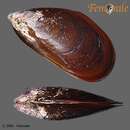en
names in breadcrumbs


“Mytilus edulis, Linné, 1758. Plate 56, fig. 4.
Shell attaining sometimes a large size, oblong-oval or triangular, dilated behind, the beaks anterior and terminal, smooth. Beaks slightly uncinate, close together. Anterior end narrowed, pointed, and usually somewhat inflate, the dorsal margin ascending on the anterior half, the posterior part broadly rounded or almost straight. Posterior end regularly convex, the basal margin straight or more or less concave. Sculpture consisting of fine concentric growth-lines and very fine radiate striæ; under the beaks a small triangular area with prominent ribs corresponding with the hinge-teeth. Epidermis thin, dark olive-brown. Colour deep blackish-blue, sometimes whitish-yellow with brown at the anterior basal part. Interior bluish-white, black outside the pallial line, polished. Margins smooth and sharp. Hinge-plate narrow, oval with 3 or 4 teeth in each valve, which may be reduced to 2 or 1. Ligament external, long and strong, deep-seated. Adductor-scars 2, the anterior very small, behind the umbo; the posterior large, roundish, situate at the upper part of posterior end, and confluent with the long and narrow byssus retractor scar; the anterior retractor scar of the foot is small, oblong, on the dorsal side behind the beak. Pallial line simple. Byssus consisting of a round stalk, from which on all sides the threads of attachment are given off.
Diameter. – Ant.-post., 50 mm. to 120 mm.; dorso-ventral, 25 mm. to 67 mm.: thickness 17 mm. to 40 mm.
Anatomy. – Alex. Purdie, “Studies in Biology for New Zealand Students,” No. 3, 1887.
Hab. – Throughout New Zealand, but more common in the south. Auckland and Campbell Islands.
The species is abundant around the coasts of the North Atlantic, and in the Mediterranean; Strait of Magellan to St. Catharina, Brazil, and extending on the west coast of America to California; Falkland Islands; Kerguelen Island. It is not recorded from Tasmania and Australia.
Remarks. – Specimens from our subantarctic islands are of a very large size. The animal is used as food and for bait. These mussels, like those of other species, contain sometimes pearls of an inferior quality.
Fossil in the Pliocene and Pleistocene of Europe and northern parts of America, and in the Miocene and Pliocene of New Zealand.”
(Suter, 1913)